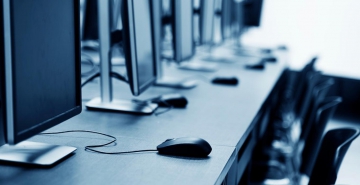The concept of the workplace has expanded to include hybrid and remote work scenarios. However, one fundamental aspect remains consistent across all settings: the importance of integrating more physical movement into daily work routines.
Insufficient physical activity ranks as the fourth major risk factor for mortality, according to the World Health Organization. This sedentary lifestyle trend has resulted in a staggering annual global healthcare cost of $24.7 billion.
Environmental, Health, and Safety (EHS) professionals should prioritize the issue of movement within the workplace due to its critical role in protecting the safety and well-being of employees. By proactively addressing movement, EHS professionals can effectively prevent immediate workplace injuries and reduce the long-term risk of developing severe diseases. Not to mention, while the United States doesn't have strict requirements regarding ergonomics, there are clear requirements in other countries. This could mean stricter, more enforced requirements may come to the United States in the future. For now, if you're an EHS professional that has clients globally, it's important to pay attention to local requirements in the area your client operates in.
In this post, we’ll cover how EHS professionals can combat the epidemic of inactivity through the implementation of a few simple solutions. We’ll look at the role microbreaks play in encouraging movement, highlight the benefits of regular movement, and share workplace health tips to enable more movement throughout the workday.
How Microbreaks Encourage Movement
Encouraging employees to incorporate regular movement breaks throughout the workday is an effective strategy to promote physical well-being, reduce the risk of musculoskeletal issues, and enhance overall productivity. One simple way to enable more movement is by promoting microbreaks.
What are microbreaks?
Microbreaks are short, frequent breaks taken during the workday that encourage employees to move more. These breaks are designed to combat the sedentary nature of many jobs and promote physical activity and movement. Workers get busy, focus on their work, and forget to take these breaks.
Benefits of microbreaks
Microbreaks provide employees with dedicated time to engage in physical activity. Whether it's a quick walk around the office, stretching exercises at their desk, or simple movements like squats or lunges, these breaks encourage employees to get up and move.
Microbreaks also help break up long periods of sitting by prompting employees to stand up, stretch, or perform light exercises.
Digital tools that encourage microbreaks
Many fitness trackers can be programmed to remind employees to move at regular intervals or challenge them to achieve a certain number of steps every hour. Some productivity tools such as task timers can be set to automatically notify workers they need to take a break after a certain amount of time has passed.
Solutions that can be seamlessly incorporated into the worker’s regular environment remove barriers to remembering to take microbreaks.
Movement: Good for the Body and the Mind
Ensuring your workforce incorporates regular movement in their daily work life offers numerous physical, mental, and productivity benefits.
- Improved circulation: Microbreak movements stimulate blood flow, delivering oxygen and nutrients to the muscles and organs, and improving overall circulation. As we use energy throughout the day toxins build up that cause blood clots, muscle tension, and contribute to fatigue and discomfort. Over time these toxins will eventually weaken our musculoskeletal structures (muscles, bones, ligaments, and tendons). We effectively wear out, and that’s when injuries can happen. Movement is the key to enhancing blood circulation that delivers the energy “building blocks” our muscles need to work throughout the day. As circulation continues through the body it removes the toxins that cause damage, while delivering greater comfort and well-being. This contributes to better long-term health.
- Musculoskeletal health and pain reduction: Extended periods of sitting can strain muscles and joints, leading to stiffness, back pain, and other musculoskeletal issues. By incorporating microbreaks, employees can perform stretching exercises, change their posture, and alleviate muscle tension.
- Increased energy and focus: Prolonged periods of inactivity can lead to mental fatigue and decreased focus. Taking microbreaks to move and engage in physical activity can combat this mental exhaustion and enhance energy levels. Movement stimulates blood flow to the brain, increasing oxygen supply and promoting alertness. Employees who incorporate regular microbreaks often report improved concentration, enhanced cognitive function, and increased productivity.
- Stress reduction and emotional well-being: Microbreaks not only benefit physical health but also contribute to emotional well-being. Engaging in movement and exercise releases endorphins, which are natural mood-boosting hormones. By taking short breaks to stretch, walk, or perform light exercises, employees can reduce stress levels, alleviate feelings of tension, and promote a positive emotional state.
- Enhanced productivity and creativity: Contrary to popular belief, taking frequent breaks throughout the workday can actually enhance productivity and creativity. By incorporating movement, employees can combat the monotony of extended periods of sedentary work, combat mental fatigue, and promote fresh thinking.
Incorporating microbreaks into the work routine is a proactive measure that EHS professionals can advocate to support employee health and well-being.
Incorporating Healthy Movement in Remote and Hybrid Work Environments
Establishing a healthy workspace
When employees work from home, it is crucial to ensure they have a healthy and ergonomic workspace that promotes comfort and reduces the risk of musculoskeletal issues. The kitchen table, or worse, a counter top and a barstool are not a healthy workplace.
- Proper chair and desk height: Employees should have a chair and desk that are adjustable to their body proportions. The chair should provide good lumbar support, and the desk height should allow for a relaxed posture with arms parallel to the floor and feet flat on the ground or a footrest. Adjustable desks that give the option for standing are great!
- Posture: Encourage employees to maintain a good posture while working. They should sit up straight, with their back supported, shoulders relaxed, and feet firmly planted on the ground. Avoiding slouching or hunching over the desk helps prevent strain on the neck, back, and shoulders. Use an imaginary plumbline to align your ears over your shoulders, and your shoulders over your hips.
- Equipment positioning: Positioning of computer monitors, keyboards, and mice should be optimized for comfort and proper alignment. The top of the monitor should be at eye level, and the keyboard and mouse should be at a comfortable distance, allowing for relaxed arm and wrist positions.
Learn more: How To Set Up a Home Office: Basic Ergonomic Tips
Home office exercise routine
To combat the sedentary nature of home-based work, employees should incorporate regular exercises and stretches into their workday. Here are some suggested exercises and stretches:
- Microbreak exercises: Encourage employees to take short exercise breaks every hour or so. These breaks can include simple exercises like squats, lunges, jumping jacks, or push-ups to get the blood flowing and engage different muscle groups.
- Stretching routine: Provide employees with a list of stretching exercises they can perform at their desk. These may include neck stretches, shoulder rolls, wrist and finger stretches, seated turning, and leg stretches. These exercises increasing blood circulation that can help relieve tension, improve flexibility, and prevent muscle stiffness.
- Movement breaks: Encourage employees to take brief movement breaks throughout the day. This can involve walking around the house, climbing stairs, or doing household chores. Movement breaks not only promote physical activity but also provide mental refreshment, enhancing focus and productivity.
Self-care and mindfulness
Working from home can blur the boundaries between work and personal life, leading to increased stress and burnout. Teaching remote and hybrid workers about factors of holistic office ergonomics such as lighting, temperature, and noise levels can improve their sense of well-being at work. Encouraging self-care activities and mindfulness practices can support employees' physical and mental well-being.
Get Your Workforce Moving
By prioritizing a healthy workspace, incorporating exercise routines, and emphasizing self-care and mindfulness practices, home-based employees can maintain their physical and mental well-being while working remotely. Proactively providing guidance and resources for creating a healthy work environment and promoting movement can contribute to increased productivity, reduced discomfort, and improved overall job satisfaction.
Movement is Part of a Healthy Lifestyle
We should remember that the necessity of enhancing movement and using better work practices (ergonomics) doesn’t “clock out” at the end of the day. Adopting an ergonomic lifestyle promotes the benefits discussed in this post for the long-term. Stay tuned for the next post when we will help you begin changing those ingrained bad habits, and usher in new healthy ones.
Learn more about ergonomics in the workplace from Antea Group.
Want more news and insights like this?
Sign up for our monthly e-newsletter, The New Leaf. Our goal is to keep you updated, educated, and even a bit entertained as it relates to all things EHS and sustainability.
Have any questions?
Contact us to discuss your environment, health, safety, and sustainability needs today.







